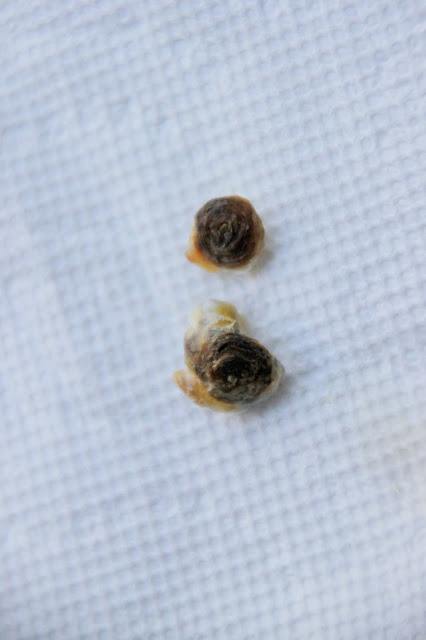Mites mites MITES !!!!!
She has bumble foot.
Here’s what you’ll need to help her:
- Bath Towel
- Clean kitchen sink
- Gloves
- Epsom Salt
- Neosporin or Duoderm Gel
- Vetericyn
- Duoderm GFC (available online or at your local medical supply store)
- Vet Wrap
- Medical Tape
Fill the sink with about a gallon of warm water and add Epsom salt to create a bath that even you would like to soak in.
Then wrap your chicken in the bath towel; being sure to wrap the wings securely and leaving her feet out. The towel will help keep her calm and also allow you to do the treatment all alone without any helpers.
Next soak your chicken’s feet in the Epsom salt bath for 10 minutes. This helps to loosen up the plug that had built up.The plug is actually comprised of dead tissue and other exudate from inside the foot that develops on the pad of the foot when it attempts to heal. The black “scab” is called eschar. In people sometimes we leave them alone and other times we soften the eschar and remove it gently in order to speed up the healing process.
In bumblefoot, the eschar can vary in size. They are hard but soften beautifully with a nice good soaking. This allows you to work on the plug in a non-surgical manner without this use of a scapel.
A view from above- the bigger one is pencil eraser sized.
Next with a gloved hand gently try to work the plug from around the edges of the eschar on the bottom of your chicken’s foot. If it is not ready do not force it. You don’t want it to bleed. Simply return to soaking for another 5-10 minutes. Give it time and be patient.
The plug should release with a bit of manipulation. It should not bleed, but if it does, don’t worry. Apply a bit of pressure to the bottom of the foot for a few minutes. It will stop.
The goal is to have to plug release naturally without much trauma because right underneath the plug is healthy tissue already working to heal the foot. When that bed of healthy tissue is damaged or cut into you are actually taking steps backwards in the body’s healing process.
The underside of the kernels. No blood just nasty soft tissue from the body trying to heal itself. The tissue on the foot pad looks nice and healthy.
Once the plug is removed, dry the foot completely and spray with Vetericyn. Allow it to air dry. While waiting give your girl some love. She is going to feel much better now.
Next apply a bit of Neosporin to the bottom of the foot pad. Instead of this you can also use Duoderm Gel to fill the wound. Next, cut a circle to fit the wound from the Duoderm GFC, center it on the wound to completely cover the wound edges and then wrap the foot pad with vet wrap. The vet wrap should be snug but tight. You don’t want to affect the circulation and blood flow to the foot. So the toes should be warm even once you apply the vet wrap. Put a bit of medical tape over the end to prevent it from coming undone. Phew, you did it!
Be sure to disinfect your work area and sink with a 10% bleach solution after you are done.
This girl should be separated for a bit from the others during healing. A diet of layer pellets is good, but supplement her with high protein snacks like meal worms and sunflower seeds to help her heal faster. Add some vitamins and electrolytes to the water too. Birds that are deficient in Vitamin A are more prone to developing bumblefoot. For her makeshift home, do not allow her to roost until healed and have a thick layer of pine shavings so her feet are comforted when walking. If she must roost, add a layer of padding by wrapping the roosts in towels to soften where she sits.
Change the bandage in the same fashion every few days or sooner as needed. Because of the Duoderm GFC you can change the bandage less frequently (you can even leave it on for a week if the bandages remain intact and the foot is showing no signs of infection). Also monitor for signs and symptoms of infection that can include warmth and redness at the site, foul smelling drainage from the wound and an overall sick appearance. If this occurs, a visit to the vet is probably necessary for some oral antibiotics and possible surgical wound treatment.





